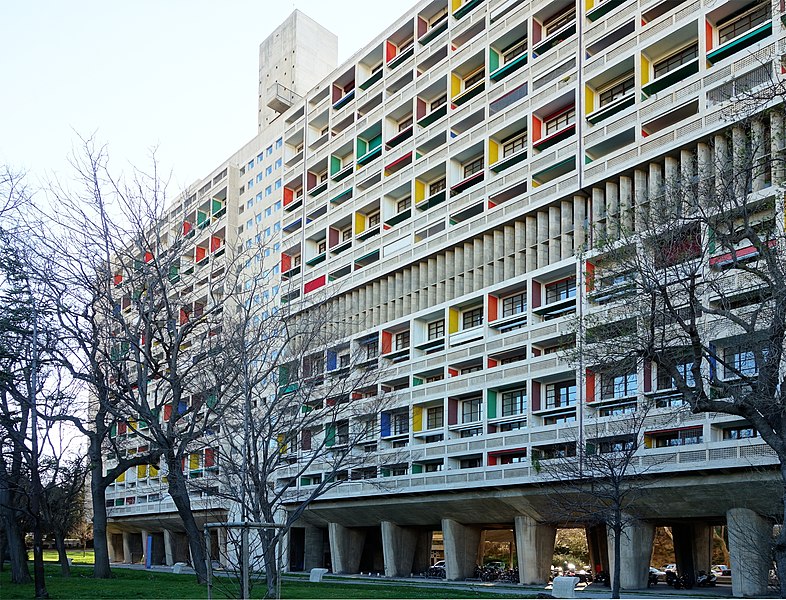Cite Radieuse
Cite Radieuse (Radiant City), is a high-density residential development, characteristic of the Unite d’habitation concept design developed by Le Corbusier.
Located in Marseille, France, Cite Radieuse is arguably the most influential Brutalist building of all time, and is considered one of Le Corbusier’s most famous and successful works. Indeed, the building is often credited as being the initial inspiration behind the architectural style of Brutalism.
Built between 1947 and 1952, the design applied Le Corbusier’s famous dictum that a house was a ‘machine for living in’, to an entire community. In so doing, it redefined high-density housing by creating a self-contained 18-storey block structured like an ocean liner.
The building is situated at the centre of a large urban park, and is 165 m long and 56 m high.
Departing from his trademark smooth white surfaces, Le Corbusier chose to construct the building in beton brut (rough-cast concrete), textured by the timber formwork. This was a matter of expediency, since a steel frame would have been too expensive considering post-WW2 material shortages, but subsequently became a design staple of Brutalism.
The building is raised up off the ground on chunky concrete piloti, and its long elevations comprise a series of balconies and deep-set windows that create a strong visual grid. Le Corbusier based this grid on his Modulor Man concept of measurement that he created to achieve designs based on human proportions.
Corridors extend through the centre of the long axis on every third floor of the building, referred to as ‘internal streets’. Most of the 337 apartments are arranged as 2-storey duplexes with a double-height living room at one end, stretching from one side to the other. Pairs of apartments interlock around the central access corridor. The apartments accommodate 1,600 residents, and the building also includes shops, sport and medical facilities, a hotel and restaurant.
Le Corbusier designed the building’s flat roof to serve as a communal terrace, together with sculptural ventilation stacks, a running track and children’s paddling pool.
When the building was unveiled, it was immediately celebrated by the architectural community as a success. The architect Walter Gropius is reported to have said at the opening event, “any architect who does not find this building beautiful, had better lay down his pencil.”
Despite influencing countless system-built residential blocks, the concept has frequently proven unsuccessful elsewhere, with some theorising this was becuase the generous proportions of Cite Radieuse were not adopted.
Between 2010 and 2013, the roof underwent renovation, and an exhibition centre was created. In 2016, it was designated a UNESCO World Heritage Site and was classified as a historic monument by the French Ministry of Culture.
[edit] Related articles on Designing Buildings Wiki
Featured articles and news
The UK's Modern Industrial Strategy: A 10 year plan
Previous consultation criticism, current key elements and general support with some persisting reservations.
Building Safety Regulator reforms
New roles, new staff and a new fast track service pave the way for a single construction regulator.
Architectural Technologist CPDs and Communications
CIAT CPD… and how you can do it!
Cooling centres and cool spaces
Managing extreme heat in cities by directing the public to places for heat stress relief and water sources.
Winter gardens: A brief history and warm variations
Extending the season with glass in different forms and terms.
Restoring Great Yarmouth's Winter Gardens
Transforming one of the least sustainable constructions imaginable.
Construction Skills Mission Board launch sector drive
Newly formed government and industry collaboration set strategy for recruiting an additional 100,000 construction workers a year.
New Architects Code comes into effect in September 2025
ARB Architects Code of Conduct and Practice available with ongoing consultation regarding guidance.
Welsh Skills Body (Medr) launches ambitious plan
The new skills body brings together funding and regulation of tertiary education and research for the devolved nation.
Paul Gandy FCIOB announced as next CIOB President
Former Tilbury Douglas CEO takes helm.
UK Infrastructure: A 10 Year Strategy. In brief with reactions
With the National Infrastructure and Service Transformation Authority (NISTA).
Ebenezer Howard: inventor of the garden city. Book review.
The Grenfell Tower fire, eight years on
A time to pause and reflect as Dubai tower block fire reported just before anniversary.
Airtightness Topic Guide BSRIA TG 27/2025
Explaining the basics of airtightness, what it is, why it's important, when it's required and how it's carried out.
Construction contract awards hit lowest point of 2025
Plummeting for second consecutive month, intensifying concerns for housing and infrastructure goals.
Understanding Mental Health in the Built Environment 2025
Examining the state of mental health in construction, shedding light on levels of stress, anxiety and depression.























Comments
The featured building is NOT the Cité Radieuse in Marseille, but apparently the Housing Unit built by Le Corbusier upon the same blue print in Briey la Forêt in Eastern France. Five Housing Units were built, including the one in Marseille (1946-52), Rezé (1953-55), West Berlin (1957-58), Briey La Forêt (1959-60) and the latest in Firminy (1965-67). The one in Marseille is the only one encapsulating all principles of the vertical city (Public School, roof top opened to public, public spaces, shops and spaces for profesional activities...). It now also host an international art center (MAMO) and a Third space for architecture (Kolektiv Cité Radieuse). All Housing Units are UNESCO listed since 2016.
Maxime Forest, Kolektiv Cité Radieuse Marseille
Thank you for offering this correction. The image has been updated.
--Editor, Designing Buildings